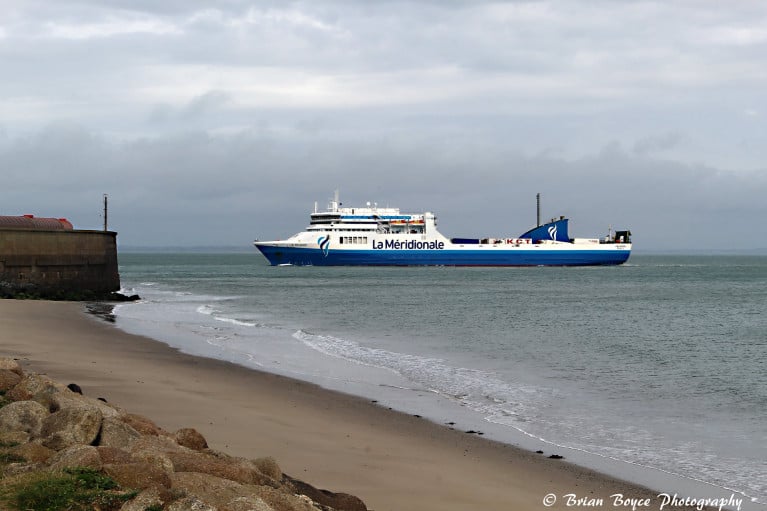Two chartered ferries from the 'Med' for 'Brexit-bypass' roles serving rival operators, where relatively close to each other offshore of Rosslare Europort last night when bound for French ports, writes Jehan Ashmore.
Irish Ferries chartered ro-ro Mega Express Four of Corsica Ferries which Afloat observed in Dublin Bay in the late afternoon, was estimated to be offshore of Rosslare some three hours later.
This proved to be so as the Dublin-Cherbourg (weekend) serving Mega Express Four was tracked off the Wexford coast in the early evening, while almost parallel was DFDS Rosslare-Dunkirk newcomer, ro-pax Pelagos, chartered from La Méridionale.
The Marseille based operator having only acquired the ro-pax in 2019 from DFDS which operated the 114 freight trailer unit ferry with a maiden crossing from Dunkirk completed on Thursday.
The debut of Pelagos was somewhat delayed as the ro-pax was meant to enter service on Tuesday, to directly replace Drotten, which too was on charter but only since late January. Swedish owners, Destination Gotland having as scheduled required that the ship return for Easter.
As for Pelagos, is of the prolific Visentini shipbuilder's early generation of ro-pax designed ferries that joins another ferry from the same Italian yard, Kerry which remains one of the original vessels that began the new Ireland-France route to Europe two days post-Brexit.
This is the first time these ports have been linked and the French port is the most eastern, compared to the Rosslare-Le Havre route which LD Lines had operated.
Pelagos is now the third DFDS vessel operating the near 24 hour route. The final vessel of the trio is Visby, sister of Drotten, however DFDS announced that a fourth freight ferry is to enter service in early April to meet the boom in demand from freight hauliers.
When Ark Dania starts service in early April, the DFDS route will increase to 16 sailings per week to and from Dunkirk. The northern France port is situated close to the major markets of the BeNelux nations, the French capital and beyond to central Europe.
Ironically, Pelagos previously spent a career with DFDS as their Liverpool Seaways, when the Danish operator had a short spell of operations on the Irish Sea more than a decade ago. As the name of the ferry indicates, the ro-pax linked Merseyside (albeit Birkenhead) with Dublin Port, where a sister, Dublin Seaways also served until the route closed in early 2011.
A third ferry from the Mediterranean, ro-ro ferry Blue Star 1 has just been chartered from Attica Group for Irish Ferries Rosslare-Pembroke route in April. This will see parent owners, ICG, redeploy the Ireland-Wales route cruiseferry Isle of Inishmore by launching on the Dover-Calais route in July.
Therefore, ICG's most notable move, will for the first time be able to offer customers as a single UK 'land-bridge' operator on the alternative service across the Strait of Dover and on the Irish Sea.
































































